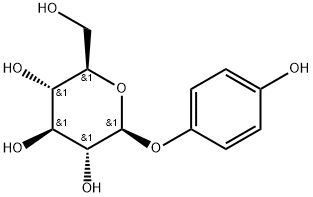Arbutin
- CAS No.
- 497-76-7
- Chemical Name:
- Arbutin
- Synonyms
- beta-arbutin;β-Arbutin;UVASOL;P-ARBUTIN;b-Arbutin;hydroquinone O-β-D-glucopyranoside;4-hydroxyphenyl-beta-d-glucopyranosid;4-HYDROXYPHENYL-BETA-D-GLUCOPYRANOSIDE;URSIN;Uresol
- CBNumber:
- CB6670456
- Molecular Formula:
- C12H16O7
- Molecular Weight:
- 272.25
- MDL Number:
- MFCD00016915
- MOL File:
- 497-76-7.mol
| Melting point | 195-198 °C |
|---|---|
| Boiling point | 375.31°C (rough estimate) |
| alpha | -64 º (c=3) |
| Density | 1.3582 (rough estimate) |
| refractive index | -65.5 ° (C=4, H2O) |
| storage temp. | Inert atmosphere,Room Temperature |
| solubility | H2O: 50 mg/mL hot, clear |
| pka | 10.10±0.15(Predicted) |
| color | White |
| optical activity | [α]/D -64.0±2.0°, c = 3 in H2O |
| Water Solubility | 10-15 g/100 mL at 20 ºC |
| Sensitive | Hygroscopic |
| Merck | 14,773 |
| BRN | 89673 |
| Stability | Stable. Hygroscopic - store under dry nitrogen. |
| InChIKey | BJRNKVDFDLYUGJ-RMPHRYRLSA-N |
| LogP | -1.350 |
| CAS DataBase Reference | 497-76-7(CAS DataBase Reference) |
| EWG's Food Scores | 1 |
| FDA UNII | C5INA23HXF |
| EPA Substance Registry System | .beta.-D-Glucopyranoside, 4-hydroxyphenyl (497-76-7) |
SAFETY
Risk and Safety Statements
| Symbol(GHS) |  GHS07 |
|||||||||
|---|---|---|---|---|---|---|---|---|---|---|
| Signal word | Warning | |||||||||
| Hazard statements | H315-H319-H335 | |||||||||
| Precautionary statements | P261-P305+P351+P338 | |||||||||
| Hazard Codes | Xn | |||||||||
| Risk Statements | 20/21/22-36/37/38 | |||||||||
| Safety Statements | 22-24/25-36-26 | |||||||||
| WGK Germany | 3 | |||||||||
| RTECS | CE8863000 | |||||||||
| F | 3-10-23 | |||||||||
| HS Code | 29389090 | |||||||||
| NFPA 704 |
|
Arbutin price More Price(70)
| Manufacturer | Product number | Product description | CAS number | Packaging | Price | Updated | Buy |
|---|---|---|---|---|---|---|---|
| Sigma-Aldrich | A4256 | Arbutin ≥98% | 497-76-7 | 10g | $174 | 2024-03-01 | Buy |
| Sigma-Aldrich | PHL89510 | Arbutin phyproof? Reference Substance | 497-76-7 | 100MG | $262 | 2024-03-01 | Buy |
| Sigma-Aldrich | 00890590 | Arbutin primary pharmaceutical reference standard | 497-76-7 | 50mg | $254 | 2023-06-20 | Buy |
| Sigma-Aldrich | 66468 | Arbutin analytical standard | 497-76-7 | 50MG | $105 | 2022-05-15 | Buy |
| TCI Chemical | A0522 | Arbutin >95.0%(HPLC) | 497-76-7 | 5g | $55 | 2024-03-01 | Buy |
Arbutin Chemical Properties,Uses,Production
Skin Whitening
Arbutin, which is derived from the leaves of ericaceae plants such as bearberry and bilberry, is a popular ingredient in whitening skin care products. It is a safe and effective whitening agent that can help reduce and eliminate skin freckles, acne, hyperpigmentation, and age spots without causing irritation or other side effects. However, arbutin is susceptible to hydrolysis and should be used in a pH range of 5 to 7 and with appropriate antioxidants such as sodium bisulfate and vitamin E for improved stability and efficacy. In addition to its whitening properties, arbutin also has moisturizing, softening, anti-inflammatory, healing, and anti-dandruff effects.
Ursolic acid vs α- arbutin
Ursolic acid is a triterpene compound naturally found in plants. It has various biological effects, including calming, anti-inflammatory, antibacterial, anti-diabetic, anti-ulcer, and hypoglycemic properties.
Alpha-arbutin is a skin-repairing agent that can improve the transparency of damaged skin caused by UV radiation. It is not easily decomposed by enzymes present on the skin surface and is ten times more effective than beta-arbutin. It can penetrate deeply into the skin, inhibit tyrosinase activity, and prevent melanin production, thereby resulting in brighter, more even-toned skin.
Photosensitivity
Arbutin can reduce melanin formation by inhibiting the activity of tyrosinase, an enzyme that generates melanin. Its action principle is similar to hydroquinone, a whitening drug. Arbutin concentration above 7% may cause photosensitivity, so 7% is considered a safety critical point. Skincare products have provisions for ingredient concentration, with a maximum 7% concentration for arbutin. This concentration range is safe from light sensitivity, although direct light exposure should still be avoided. When absorbed by the skin, arbutin reacts to light, breaking down into hydroquinone for a whitening effect. Hydroquinone concentration in arbutin skincare is usually less than 20 PPM, which is too low to cause side effects such as skin darkening.
Uses
Diuretic and anti-infective drugs of urinary system. Color photographic developing stabilizer. Whitening, anti-freckle, hair care in cosmetics.
Description
Arbutin is a β-D-glucopyranoside HQ derivative and a plant-derived compound found in the dried leaves of several plant species, including blueberry, cranberry, bearberry, and pear trees. It suppresses tyrosinase activity without altering RNA expression.
Description
Arbutin is a glycosylated hydroquinone that has been found in Arctostaphylos plants and has diverse biological activities, including tyrosinase inhibitory, antioxidant, and anti-inflammatory properties. It inhibits human tyrosinase activity in crude tyrosinase solution isolated from human melanocytes (IC50s = 5.7 and 18.9 mM using L-tyrosine and L-DOPA as substrates, respectively) as well as in intact melanocytes (IC50 = 0.5 mM). Arbutin (50 μM) inhibits hemolysis induced by the free radical generator AAPH in sheep erythrocytes and inhibits AAPH-induced decreases in cell viability in cultured human skin fibroblasts when used at concentrations greater than 125 μM. In an LPS-induced rat model of acute lung injury, arbutin (50 mg/kg) prevents increases in IL-1β, IL-6, and TNF-α levels in lung tissue and serum. Formulations containing arbutin have been used in the treatment of hyperpigmentation disorders.
Chemical Properties
Arbutin is also known as hydroquinone glucoside and has two optical isomers, α and ?, with the latter having biological activity. At room temperature, it appears as a white powder with a slight yellowish tint that is soluble in water, methanol, ethanol, propylene glycol, and glycerin aqueous solutions without precipitation. However, it is insoluble in chloroform, ether, and petroleum ether.
Physical properties
Appearance: white powder. Solubility: soluble in hot water. Melting point: 198–201?°C
History
Arbutin is a hydroquinone compound with two epimers, α and β arbutin. The sources
of α-arbutin and β-arbutin are completely different. β-arbutin can be prepared by
plant extraction, plant cell culture, and artificial synthesis. Arbutin can relieve cough
and asthma and has whitening effect.
The Japanese cosmetics company Shiseido developed the arbutin as a whitening
agent in the 1990s. Arbutin can not only reduce skin freckles, senile plaques, and
chloasma but also relieve acne and improve healing after skin burns. Arbutin is the
epimer of β-arbutin, and the spatial orientation of their glycosidic bonds is just the
opposite. Alpha arbutin is generally prepared by different microbial enzymes. A
molecule of glucose and a molecule of hydroquinone combine to form a molecule
α-arbutin . Alpha arbutin improves ultraviolet burn scar. α-Arbutin can be used in
a variety of skin whitening cosmetics since it is chemically stable.
Uses
veterinary drug
Uses
arbutin is used primarily for its anti-oxidant and bleaching properties. Arbutin is the active constituent of bearberry, and found in other plant sources, including wheat. It acts as a tyrosinase inhibitor by converting to hydroquinone, and thus can prevent melanin formation.
Uses
Antibacterial; tyrosinase inhibitor, depigmentor, antitussive
Uses
Arbutin is a glycosylated hydroquinone extracted from bearberry plant. Arbutin is a known inhibitor of tyrosinase, which in turn prevents the formation of melanin. Arbutin is often used as a skin-ligh tening agent in cosmetic products.
Definition
ChEBI: Arbutin also called Hydroquinone O-beta-D-glucopyranoside, is a monosaccharide derivative that is hydroquinone attached to a beta-D-glucopyranosyl residue at position 4 via a glycosidic linkage. It has a role as a plant metabolite and an Escherichia coli metabolite. It is a beta-D-glucoside and a monosaccharide derivative. It is functionally related to a hydroquinone.
Indications
Arbutin has bactericidal, anti-inflammatory, and whitening effects and is mainly used in whitening cosmetics.
Pharmacology
Arbutin could effectively inhibit the activity of tyrosinase in skin cells and block the formation of melanin without affecting cell proliferation . Furthermore, it could accelerate the decomposition and excretion of melanin and thereby reduce skin pigmentation and eliminate freckles. In addition, arbutin shows no toxicity, irritation, sensitization, and other side effects . Alpha arbutin is safer and has a stronger inhibitory effect on tyrosinase. At present the whitening cosmetics market in the developed countries has been almost monopolized by arbutin.
Clinical Use
Arbutin is mainly used in high-level cosmetics and has been formulated into skin cream, freckle cream, and senior pearl cream. Arbutin is a major component of medicine for treating burn and scald, characterized by rapid elimination of pain and swelling and fast healing, leaving no scars. Arbutin can also be used as raw materials for intestinal anti-inflammatory drug, with sterilization, anti-inflammatory effect, and nontoxic side effects.
Purification Methods
The glycoside from Protea exima is purified by recrystallisation from H2O or moist EtOAc (as monohydrate), after chromatography through silica Gel using EtOAc/MeOH. Crystallisation from EtOH/CHCl3 gives crystals m 199-200o with intermediate melting at 164o and resolidifying. The pentaacetate crystallises from EtOH in fine needles with m 145-146o, [] D 20 -28.2o (c 2, Me2CO). [Robinson & Waters J Chem Soc 2729 1930, IR, NMR, MS: Perold et al. J Chem Soc, Perkin Trans 1 239 1979, Beilstein 17/7 V 110.]
Arbutin Preparation Products And Raw materials
Raw materials
Preparation Products
| Supplier | Tel | Country | ProdList | Advantage | |
|---|---|---|---|---|---|
| Hefei TNJ Chemical Industry Co.,Ltd. | 0551-65418671 | sales@tnjchem.com | China | 34572 | 58 |
| Hubei Aumei New Material Co., Ltd. | +86-027-87366298 +8615927270571 | tianyi@skbiology.cn | China | 294 | 58 |
| Shandong Zhishang New Material Co., Ltd. | +8617653113209 | sales002@sdzschem.com | China | 3050 | 58 |
| Shaanxi LonierHerb Bio Technology Co Ltd | +86-86-+86-86-029-87551862 +8617702909819 | sales006@ingredients-lonier.com | China | 2596 | 58 |
| Wuhan Quanjinci New Material Co.,Ltd. | +8615271838296 | kyra@quanjinci.com | China | 1532 | 58 |
| Chongqing Zhihe Biopharmaceutical Co., Ltd. | +86-18580541567 +86-17782035140 | sales@zhswyy.com | China | 338 | 58 |
| Sinoway Industrial co., ltd. | 0592-5800732; +8613806035118 | xie@china-sinoway.com | China | 992 | 58 |
| Firsky International Trade (Wuhan) Co., Ltd | +8615387054039 | admin@firsky-cn.com | China | 436 | 58 |
| Henan Bao Enluo International TradeCo.,LTD | +86-17331933971 +86-17331933971 | deasea125996@gmail.com | China | 2503 | 58 |
| Anhui Ruihan Technology Co., Ltd | +8617756083858 | daisy@anhuiruihan.com | China | 994 | 58 |
Related articles
- Pharmacological action and Preparation of Arbutin
- Arbutin was originally a natural active substance extracted from the bearberry tree, which can remove freckles, butterfly spot....
- Jul 12,2022
Related Qustion
- Q:Is arbutin safe to use every day?
- A:Arbutin exhibits different toxicity levels depending on the cell type and exposure time, but 1 mM is considered a boundary con....
- Apr 18,2024
View Lastest Price from Arbutin manufacturers
| Image | Update time | Product | Price | Min. Order | Purity | Supply Ability | Manufacturer | |
|---|---|---|---|---|---|---|---|---|
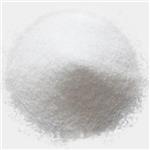 |
2024-04-19 | Arbutin
497-76-7
|
US $125.00-110.00 / kg | 1kg | 99.99% | 100Tons | Hebei Dangtong Import and export Co LTD | |
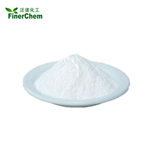 |
2024-04-19 | Arbutin
497-76-7
|
US $0.00 / Kg/Drum | 1KG | 99% | 200mt | Jinan Finer Chemical Co., Ltd | |
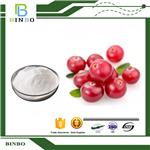 |
2024-04-11 | Arbutin
497-76-7
|
US $0.00 / kg | 1kg | 99.8% | 1000 kg | BINBO BIOLOGICAL CO.,LTD |





